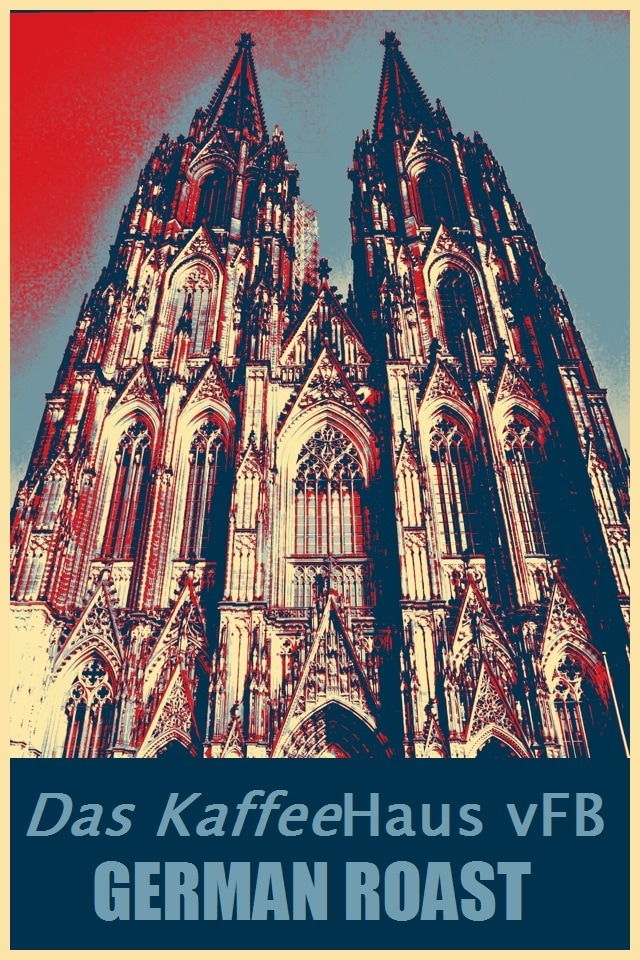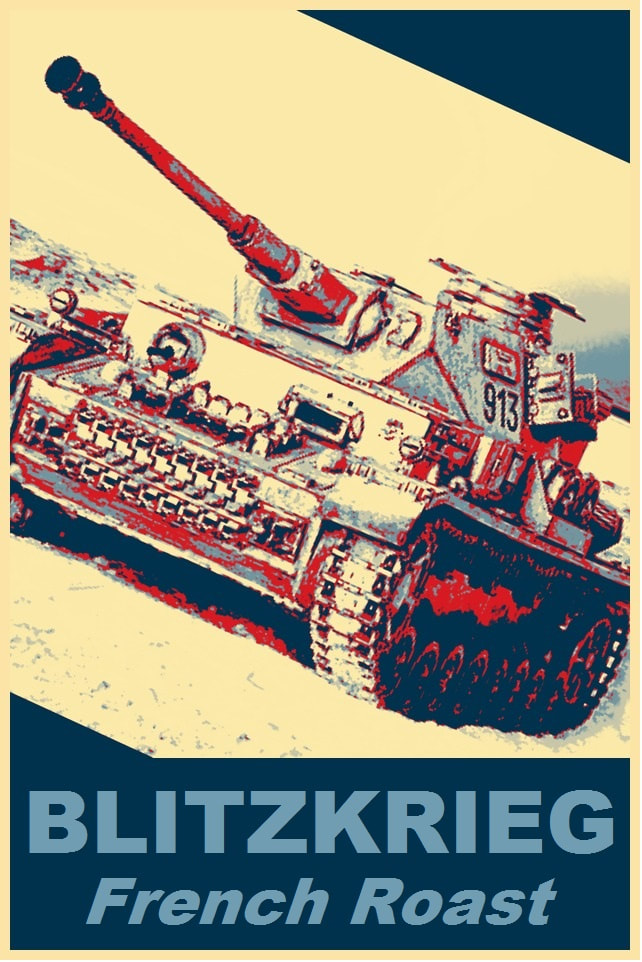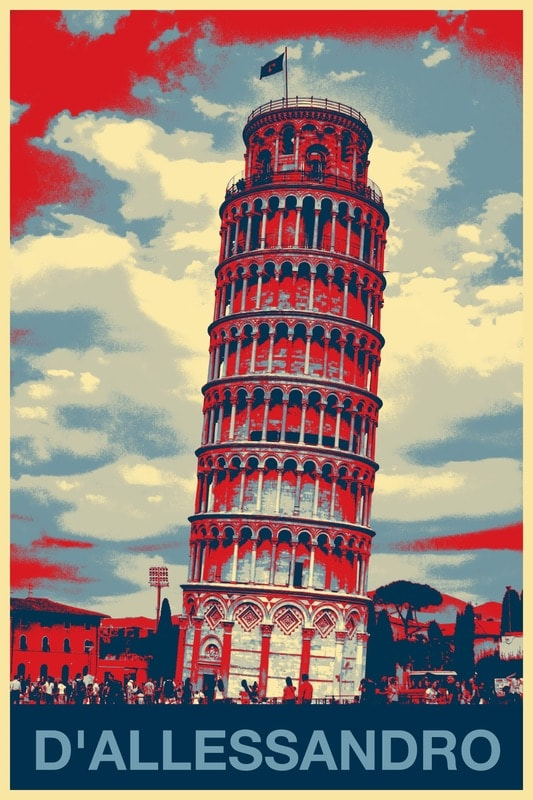Kaffee Roasts, Pastries, & Food...

DAS KAFFEEHAUS GERMAN ROAST:
Our Famous German house roast that is a German full city utility roast made up of Santos, Columbian, & Costa Rican.
Why is it so different - clean finishing - less harsh, and brilliant!? Well, it is a far cry from what Americans have been told to expect by the current coffee establishment – it is NOT dripped espresso or even close to it. It is a German light roast (by our standards – BOLD by German standards) that is found throughout Germany - derived from a roast recipe that dates back to 1632 from Aachen, Germany - it is the roast that inspired our entire company!
Our Famous German house roast that is a German full city utility roast made up of Santos, Columbian, & Costa Rican.
Why is it so different - clean finishing - less harsh, and brilliant!? Well, it is a far cry from what Americans have been told to expect by the current coffee establishment – it is NOT dripped espresso or even close to it. It is a German light roast (by our standards – BOLD by German standards) that is found throughout Germany - derived from a roast recipe that dates back to 1632 from Aachen, Germany - it is the roast that inspired our entire company!
|
SCHWARZENEGGER AUSTRIAN ROAST:
Full bodied muti-sourced arabica bean; Viennese / Austrian roast. This is the "beginning" of a "bold" roast (by American standards) and is just below an American roast. It is roasted just long enough to bring SOME of the coffee oils to the surface of the bean. Very difficult roast to master: roasted a smidgen too long and it is a Blitzkrieg - not long enough and it's an American Roast. It is from a recipe acquired in Kumberg, Austria - about 30 minutes from Graz, Austria (Arnold Schwarzenegger's hometown). It carries the attitude of "The Arnold" & it is our tribute to him! We salute you Governator! |
|
BLITZKRIEG FRENCH ROAST:
A lightning war of BOLD & DARK French roast body and taste using a single sourced arabica bean. A classic French roast is roasted almost to the point of burning the bean (creating the signature flavor of this roast). The resulting beverage is nearly always very dark in color, and has a distinctive caramelized taste. In many places, French roast is the darkest roast available. Leaving beans in the fire for about a minute longer yields Italian or Spanish roast, both of which are right on the brink of incineration., with our trademark clean and quick finish with zero aftertaste. |
|
D'ALLESSANDRO ITALIAN ESPRESSO ROAST:
A multi source blend of Austrian and Italian roasted arabica beans that results in a heavy "old school" rich European espresso with plenty of crema - however, still a clean and crisp finish. Many people enjoy Italian roast because though the blend is dark (yet NOT as dark as French), it tends to have a sweeter and less acidic taste than other dark roasts like French Roast (even though OURS have very little of this characteristic). Contrary to popular belief, dark roasted coffee like Italian or French roast is not any stronger than lighter roasts. In fact, the opposite is true. A longer roasting time depletes the natural caffeine sources in the beans and results in a coffee that contains less caffeine, though this difference can be marginal. Our Kalt Brauen (cold brew) espresso is comprised of this roast and we use a very cold filtered and brewed process that we learned in Germany. |
Speisekarte
Your browser does not support viewing this document. Click here to download the document.
Gebäck (pastries)
The following are some of our signature pastries and other fare (with a brief description) that are commonly found at our MAIN STORE: Jane's Bagels: Jane Blystone, of Harvest Moon fame and now joint proprietor (with her husband Joe) of Blystone Farms in Canal Winchester, is the mastermind behind our wunderbar begals! She concocts several famous varieties that include: Plain, Cinnamon Raisin, Asiago Cheese, Tomato Basil, Jalapeno, Spinach, & Everything. They are quite popular and well known locally. You can call in a special order anytime by contacting us at 614-837-8837.
über Cinnamon Schnecken: Schnecken!? What is schnecken you ask... Well the word schnecken in German translates to snail - so these are snail shaped pastries or what became known as the ever popular cinnamon roll here in America (yes - our cinnamon rolls that we know and love are German schnecken) These ENORMOUS 6oz. monsters were inspired by the large cinnamon schnecken that Herr Joseph enjoyed in Germany. They are truly unreal!
Apfel/Kirsche Schnecken: Inspired by the many fruit topped schecken enjoyed all throughout Germany.
Apple Strudel: (German: Apfelstrudel) is a traditional Viennese strudel, a popular pastry in Austria, Germany, and in many countries in Europe that once belonged to the Austro-Hungarian empire (1867–1918). Apple Strudel is a speciality of Austria and Bavaria and it is known worldwide. Its filling is made from chopped apples. Strudel is related to the Ottoman Empire's pastry baklava, and came to Austria via Turkish to Hungarian and then Hungarian to Austrian cuisine.
Berliner: A Berliner Pfannkuchen (also called Berliner Ballen or Krapfen in Germany, bombolone in Italy, Berlinerbol in the Netherlands, and bismark in Canada and parts of the United States) is a predominantly German and Central European doughnut (without a central hole) made from sweet yeast dough fried in fat or oil, with a marmalade or jam filling and usually icing, powdered sugar or conventional sugar on top. They are sometimes made with chocolate, custard, mocha, or fruit filling, or with no filling at all. Today they can be purchased throughout the year, but their origin was a special pastry for New Year's Eve. In Berlin it is a common joke at a New Year's Eve party to offer one Pfannkuchen filled with mustard.
Bienenstich: Bee sting cake - a very popular honey/almond heavenly cake!
Windbeutel (Bavarian Cream Puff): Popular Bavarian treat that is a puff pastry filled with Bavarian cream.
Umlaut: Our rendition of the faddish and currently popular "cakeball". Umlauts are the double dot punctuation in Germanic languages found over vowels. They have come to be known by most Americans in pop culture as a German aesthetic fixture in print or writing. Anything that is seen with umlauts is instantly associated by Americans to be of German association. Therefore, we "ran with it", our Umlauts are a secret cake concoction that is dipped in an irresistible dark or white chocolate. They are one of our signature items (for obvious reasons) and are a very close cousin to German Rumkugeln (minus the rum).
Kringle: a Scandinavian pastry, it is actually a Nordic variety of pretzel (believe it or not), which arrived with Roman Catholic monks in the 13th century, especially in Denmark. It developed further into several kinds of sweet, salty or filled pastries. Our Kringles are hand-rolled from Danish pastry dough (wienerbrød dough). Many layers of the flaky dough are layered, then shaped in an oval. After filling with fruit, nut, or other flavor combinations, the pastry is baked and iced. Racine, Wisconsin, has historically been a center of Danish-American culture and the home of the American rendition of the Kringle.
Apfeltasche/Kirschtasche (Fruit Turnover) a staple pastry in Germany - light, fluffy puff pastry with our signature fruit fillings.
Topfenkolatsche (Cheese Danish) & Obst Kolatsche (Fruit Danish): A pocket style Austrian pastry with cheese (Topfen) or fruit (Obst).
Kaffee-Kuchen & Streusel Kuchen: Sweet bread coffee cakes (or tortes) that are popular during "coffee time" in the early afternoon all throughout Germany. We also do a Apfel-Streusel Kuchen that is a Burkhart family recipe and one of our secret weapons...
Bavarian Pretzel: A staple of southern Germany - the pretzel is a timeless treat! There are numerous accounts on the origin of the looped pretzels, as well as the origin of the name; most agree that they have Christian backgrounds and were invented by monks. In Germany there are stories that pretzels were the invention of desperate bakers. The pretzel has been in use as an emblem of bakers and formerly their guilds in southern German areas since at least the 12th century.
Within the Catholic Church, pretzels were regarded as having religious significance for both ingredients and shape. Pretzels made with a simple recipe using only flour and water could be eaten during Lent, when Christians were forbidden to eat eggs, lard, or dairy products such as milk and butter. As time passed, pretzels became associated with both Lent and Easter. Pretzels were hidden on Easter morning just as eggs are hidden today, and are particularly associated with Lent, fasting, and prayers before Easter.
Pizzelle: traditional Italian (Italian?! - remember, we are European) waffle cookies made from flour, eggs, sugar, butter or vegetable oil, and flavoring (often vanilla, anise, or lemon zest). Pizzelle were originally made in the Abruzzo region of south-central Italy. The name comes from the Italian word for "round" and "flat" (pizze); this is also the meaning of the word pizza. Many other cultures have developed a pizzelle-type cookie as part of their culture (for example, the Norwegian Krumkake). It is known to be one of the oldest cookies, and is believed to have developed from the ancient Roman crustulum. Pizzelle are known as ferratelle in the Lazio region of Italy.
Killa' Bagel Breakfast Samich: An irresistible bagel concoction of egg, two cheeses (American & Provolone), and bacon that is a homer!
über Cinnamon Schnecken: Schnecken!? What is schnecken you ask... Well the word schnecken in German translates to snail - so these are snail shaped pastries or what became known as the ever popular cinnamon roll here in America (yes - our cinnamon rolls that we know and love are German schnecken) These ENORMOUS 6oz. monsters were inspired by the large cinnamon schnecken that Herr Joseph enjoyed in Germany. They are truly unreal!
Apfel/Kirsche Schnecken: Inspired by the many fruit topped schecken enjoyed all throughout Germany.
Apple Strudel: (German: Apfelstrudel) is a traditional Viennese strudel, a popular pastry in Austria, Germany, and in many countries in Europe that once belonged to the Austro-Hungarian empire (1867–1918). Apple Strudel is a speciality of Austria and Bavaria and it is known worldwide. Its filling is made from chopped apples. Strudel is related to the Ottoman Empire's pastry baklava, and came to Austria via Turkish to Hungarian and then Hungarian to Austrian cuisine.
Berliner: A Berliner Pfannkuchen (also called Berliner Ballen or Krapfen in Germany, bombolone in Italy, Berlinerbol in the Netherlands, and bismark in Canada and parts of the United States) is a predominantly German and Central European doughnut (without a central hole) made from sweet yeast dough fried in fat or oil, with a marmalade or jam filling and usually icing, powdered sugar or conventional sugar on top. They are sometimes made with chocolate, custard, mocha, or fruit filling, or with no filling at all. Today they can be purchased throughout the year, but their origin was a special pastry for New Year's Eve. In Berlin it is a common joke at a New Year's Eve party to offer one Pfannkuchen filled with mustard.
Bienenstich: Bee sting cake - a very popular honey/almond heavenly cake!
Windbeutel (Bavarian Cream Puff): Popular Bavarian treat that is a puff pastry filled with Bavarian cream.
Umlaut: Our rendition of the faddish and currently popular "cakeball". Umlauts are the double dot punctuation in Germanic languages found over vowels. They have come to be known by most Americans in pop culture as a German aesthetic fixture in print or writing. Anything that is seen with umlauts is instantly associated by Americans to be of German association. Therefore, we "ran with it", our Umlauts are a secret cake concoction that is dipped in an irresistible dark or white chocolate. They are one of our signature items (for obvious reasons) and are a very close cousin to German Rumkugeln (minus the rum).
Kringle: a Scandinavian pastry, it is actually a Nordic variety of pretzel (believe it or not), which arrived with Roman Catholic monks in the 13th century, especially in Denmark. It developed further into several kinds of sweet, salty or filled pastries. Our Kringles are hand-rolled from Danish pastry dough (wienerbrød dough). Many layers of the flaky dough are layered, then shaped in an oval. After filling with fruit, nut, or other flavor combinations, the pastry is baked and iced. Racine, Wisconsin, has historically been a center of Danish-American culture and the home of the American rendition of the Kringle.
Apfeltasche/Kirschtasche (Fruit Turnover) a staple pastry in Germany - light, fluffy puff pastry with our signature fruit fillings.
Topfenkolatsche (Cheese Danish) & Obst Kolatsche (Fruit Danish): A pocket style Austrian pastry with cheese (Topfen) or fruit (Obst).
Kaffee-Kuchen & Streusel Kuchen: Sweet bread coffee cakes (or tortes) that are popular during "coffee time" in the early afternoon all throughout Germany. We also do a Apfel-Streusel Kuchen that is a Burkhart family recipe and one of our secret weapons...
Bavarian Pretzel: A staple of southern Germany - the pretzel is a timeless treat! There are numerous accounts on the origin of the looped pretzels, as well as the origin of the name; most agree that they have Christian backgrounds and were invented by monks. In Germany there are stories that pretzels were the invention of desperate bakers. The pretzel has been in use as an emblem of bakers and formerly their guilds in southern German areas since at least the 12th century.
Within the Catholic Church, pretzels were regarded as having religious significance for both ingredients and shape. Pretzels made with a simple recipe using only flour and water could be eaten during Lent, when Christians were forbidden to eat eggs, lard, or dairy products such as milk and butter. As time passed, pretzels became associated with both Lent and Easter. Pretzels were hidden on Easter morning just as eggs are hidden today, and are particularly associated with Lent, fasting, and prayers before Easter.
Pizzelle: traditional Italian (Italian?! - remember, we are European) waffle cookies made from flour, eggs, sugar, butter or vegetable oil, and flavoring (often vanilla, anise, or lemon zest). Pizzelle were originally made in the Abruzzo region of south-central Italy. The name comes from the Italian word for "round" and "flat" (pizze); this is also the meaning of the word pizza. Many other cultures have developed a pizzelle-type cookie as part of their culture (for example, the Norwegian Krumkake). It is known to be one of the oldest cookies, and is believed to have developed from the ancient Roman crustulum. Pizzelle are known as ferratelle in the Lazio region of Italy.
Killa' Bagel Breakfast Samich: An irresistible bagel concoction of egg, two cheeses (American & Provolone), and bacon that is a homer!



